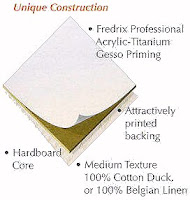
Paint. Enough said right? Well sort of. Like I've said earlier I paint with what is called a limited pallet. Which means I use almost just the primary colors to paint with and then just mix these colors to get all the colors I need. To do this you got to first understand at least a little about color theory. Which basically is for example red and blue make purple, or yellow and blue make green and so on. But then there are also warm colors cool colors and then there are opposites, color chords and even opaque and transparent colors. And on and on and on... There are collage courses and 'clubbing baby seal' size books just on this subject.
I don't want to scare any one with how complex this kind of topic can become. For me when I first started to paint I painted with a limited pallet more out of cost than out of any sort of artsy high minding ideals. An average tube of paint will run any where between $20 to $75 (at least for the type of paint I use, but more on that later). So I went with as few a colors as I could get away with. Which is around 7-9. Burnt Sienna (reddish brown), Burnt Umber (dark brown), Ultramarine Deep (blue), Titanium White, Cadmium Red Deep, Cadmium Yellow Light, Indian Yellow (a warm orange-yellow) and sometimes Dioxazine Purple and Raw Umber.
Next I took a sheet of mat board and cut it up into four inch squares that I gessoed (it's a type of primer). Then I would paint each square with a mixing of various colors to see how each color worked with each other. Red and yellow to make an orange color. After I had mixed all primary colors, red, yellow and blue. Then I mixed primary colors with secondary colors. For example red (primary) and green (secondary, made up of yellow and blue) make brown. And then depending on how much of either color you mix depends on the kind of brown you get, more red you get a redish brown and more green a greenish brown.
Now I need to warn people that when you first start mixing colors everyone seems to go through a stage of learning I like to call, 'the gray mud' stage. This is when no matter what color you are trying to mix, all you seem to be able to mix is a dead looking gray mud color. I went through it and everyone I have ever taught goes through it. This stage for most people is often the time when they quit painting (mostly because they don't have the artist disease too*). It is their first real wall. I pushed through it (and wasted a lot of paint too).
The type of paint you choose to use will in the end be more about preference or as I like to call it, how the paint feels as you mix it and how it feels as you apply it to the canvas.
The paint I use is called Maimeri Puro. It comes from Italy. I buy it from Jerry's Artarama online. The reason I use this more expensive paint is because the pigment that the paint is made from is ground to a much finer consistency then with other paints I have tried. The colors are also richer and brighter. Plus I need less of it to cover the same area as with other brands. It mixes easily and glazes much better then other brand too. which is very important to me because I do more glazing then I use to. Glazing is to apply multiple thin transparent layers of paint. But thats getting into techniques than tools, which I'll talk about later.
*The artistic disease - I once read another artist describe painting for them as a disease with no cure. All he could do is push it off for a little bit by painting. It is like a nervous itch that build up over time and the only way to make it go a way is to paint. This is painting for me too. I've met some artists who just love to paint. They will spend every waking moment in the studio painting. I always felt bad, because I didn't feel this way. There are times when I'm like this. But they are short lived and few and far between. When I studied under Greg Olsen he told me that there are times for him too that he really struggles to sit down and paint. He calls himself the laziest painter (I doubt this because he is prolific). After hearing this and reading about other artists I didn't feel so bad.
 "Santa's Littlest Helper"
"Santa's Littlest Helper"




